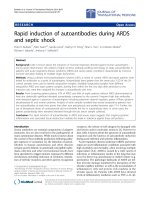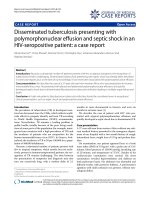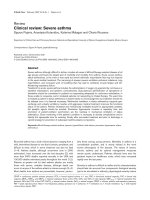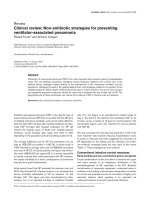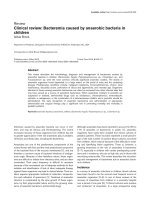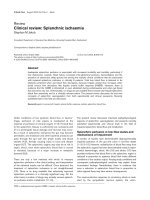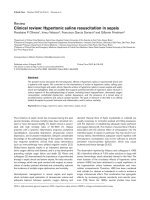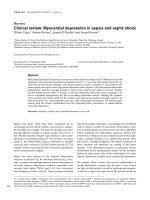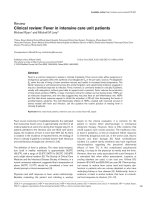Báo cáo y học: "Clinical review: Myocardial depression in sepsis and septic shock" pptx
Bạn đang xem bản rút gọn của tài liệu. Xem và tải ngay bản đầy đủ của tài liệu tại đây (525.93 KB, 9 trang )
500
CI = cardiac index; cNOS = constitutive nitric oxide synthase; CO = cardiac output; CVP = central venous pressure; IL = interleukin; iNOS =
inducible nitric oxide synthase; LVEDVI = left ventricular end-diastolic volume index; LVEF = left ventricular ejection fraction; MDS = myocardial
depressant substance; NO = nitric oxide; PAC = pulmonary artery catheter; PAWP = pulmonary artery wedge pressure; RVEF = right ventricular
ejection fraction; SVR = systemic vascular resistance; TNF-α = tumor necrosis factor alpha.
Critical Care December 2002 Vol 6 No 6 Court et al.
Sepsis and septic shock have been recognized as an
increasingly serious clinical problem, accounting for substan-
tial morbidity and mortality. The past four decades have seen
the age-adjusted mortality of sepsis increase from 0.5 to 7
per 100,000 episodes despite major advances in the under-
standing of its pathophysiology [1]. The incidence of severe
sepsis in the United States today is estimated at 750,000
cases per year, resulting in 215,000 deaths annually [2]. The
majority of these sepsis patients die of refractory hypotension
and of cardiovascular collapse.
Sepsis has been defined as the systemic inflammatory
response to infection [3]. An infectious stimulus (e.g. endo-
toxin or another microbiologic element) induces the release of
local and systemic inflammatory mediators, especially tumor
necrosis factor alpha (TNF-α) and IL-1β, from monocytes/
macrophages and other cells [4]. These cytokines stimulate
polymorphonuclear leukocytes, macrophages and endothelial
cells to release a number of downstream inflammatory media-
tors, including platelet activating factor and nitric oxide (NO),
further amplifying the inflammatory response. Several anti-
inflammatory mediators are also released as part of this ampli-
fication cascade; namely, IL-10, transforming growth factor
beta and IL-1 receptor antagonist. The relative contribution of
these cytokines will determine the severity of the septic
episode. If the inflammatory reaction is particularly intense,
homeostasis of the cardiovascular system will be disrupted,
leading to septic shock. One of the manifestations of cardio-
vascular dysfunction in septic shock is myocardial depression.
The present article reviews the clinical manifestations of
cardiac dysfunction in sepsis, from the point of view of both
the right and left ventricle, as well as cardiovascular prognos-
tic factors in sepsis and septic shock. We will also review the
Review
Clinical review: Myocardial depression in sepsis and septic shock
Olivier Court
1
, Aseem Kumar
2
, Joseph E Parrillo
3
and Anand Kumar
4
1
Fellow, Section of Critical Care Medicine, Health Sciences Center, University of Manitoba, Winnipeg, Canada
2
Assistant Professor of Medicine, Section of Critical Care Medicine, Rush–Presbyterian–St Luke’s Medical Center, Chicago, IL, USA
3
Director, Division of Cardiovascular Diseases and CCM, Cooper Hospital, Camden, NJ, USA
4
Assistant Professor of Medicine, Section of Critical Care Medicine, Health Sciences Center, University of Manitoba, Winnipeg, Canada
Correspondence: Anand Kumar,
Published online: 12 September 2002 Critical Care 2002, 6:500-508 (DOI 10.1186/cc1822)
This article is online at />© 2002 BioMed Central Ltd (Print ISSN 1364-8535; Online ISSN 1466-609X)
Abstract
Myocardial dysfunction frequently accompanies severe sepsis and septic shock. Whereas myocardial
depression was previously considered a preterminal event, it is now clear that cardiac dysfunction as
evidenced by biventricular dilatation and reduced ejection fraction is present in most patients with
severe sepsis and septic shock. Myocardial depression exists despite a fluid resuscitation-dependent
hyperdynamic state that typically persists in septic shock patients until death or recovery. Cardiac
function usually recovers within 7–10 days in survivors. Myocardial dysfunction does not appear to be
due to myocardial hypoperfusion but due to circulating depressant factors, including the cytokines
tumor necrosis factor alpha and IL-1β. At a cellular level, reduced myocardial contractility seems to be
induced by both nitric oxide-dependent and nitric oxide-independent mechanisms. The present paper
reviews both the clinical manifestations and the molecular/cellular mechanisms of sepsis-induced
myocardial depression.
Keywords contractility, cytokine, heart, myocardial depression, nitric oxide
501
Available online />potential pathophysiologic processes responsible for myocar-
dial depression in sepsis, from the perspective of organ phys-
iology and molecular biology.
Clinical manifestations of cardiovascular
dysfunction
Historical perspectives
Our understanding of the cardiovascular manifestations of
septic shock has evolved over the years, as new techniques
to assess cardiovascular performance have become avail-
able. Before the introduction of the pulmonary artery catheter
(PAC), two distinct cardiovascular clinical presentations of
septic shock were described: a high cardiac output (CO)
state, associated with warm, dry skin and a bounding pulse
despite hypotension (warm shock); and a low CO state,
associated with hypotension, cold, clammy skin and a thready
pulse (cold shock) [5]. Clowes et al. [6], in a 1966 study,
described these two clinical pictures as different stages of
septic shock: patients were believed to initially experience a
hyperdynamic phase (warm shock), and then to either recover
or progress to hypodynamic shock (cold shock) and death.
This view was reinforced by other clinical studies [5,7] that
correlated survival with high cardiac index (CI). Only a few
studies hinted at the relationship between volume status, the
CI and outcome [8,9]. All these studies that supported the
concept of terminal cold shock suffered from the fact that
they used central venous pressure (CVP) as the best avail-
able estimate of left ventricular end-diastolic volume and ade-
quacy of resuscitation. Evidence accumulated over the past
40 years shows that CVP, as a reflection of right ventricular
preload, is a poor estimate of left ventricular preload in criti-
cally ill patients, and particularly in sepsis [10].
The introduction of the PAC (which could measure pulmonary
artery wedge pressure as a more accurate estimate of left
ventricular preload) has allowed for better definition of the
cardiovascular dysfunction in septic shock and has improved
volume resuscitation. Several studies have shown that ade-
quately resuscitated septic shock patients consistently mani-
fest a hyperdynamic circulatory state with high CO and low
systemic vascular resistance (SVR) [11,12]. In contrast to
previous belief, this hyperdynamic state usually persists until
death in nonsurvivors (Fig. 1) [13,14]. Despite the strong evi-
dence characterizing sepsis as a hyperdynamic state, studies
that examined myocardial performance still showed left ven-
tricular dysfunction (illustrated by decreased left ventricular
stroke work index) in properly resuscitated septic patients
[15]. The depression in the Frank–Starling curve demon-
strated in these studies, however, could be explained by
either a change in myocardial contractility or compliance.
The development of portable radionuclide cineangiography
and its application to critically ill patients has further improved
our understanding of cardiovascular dysfunction in septic
shock, by allowing differentiation between impaired contractil-
ity and impaired compliance.
Left ventricular function
Parker et al. [16] showed, using radionuclide cineangiogra-
phy, that survivors of septic shock demonstrated a decreased
left ventricular ejection fraction (LVEF) and an acutely dilated
left ventricle, as evidenced by an increased left ventricular
end-diastolic volume index (LVEDVI) (Fig. 2). These parame-
ters returned to normal over 7–10 days in survivors. Nonsur-
vivors maintained normal LVEF and LVEDVI throughout the
course of their illness until death. All patients in this study
[16] had normal or elevated CI and low SVR, as measured by
the PAC.
In 1988, Ognibene et al. compared left ventricular perfor-
mance curves (plotting left ventricular stroke work index
versus LVEDVI) of septic and nonseptic critically ill patients
(Fig. 3). They showed a flattening of the curve in septic shock
patients, with significantly smaller left ventricular stroke work
index increments in response to similar LVEDVI increments
when compared with nonseptic critically ill controls [17].
Subsequent studies have confirmed the presence of signifi-
cant left ventricular systolic dysfunction in septic patients
[18,19].
Figure 1
The mean (± SEM) cardiac index plotted against time for all patients,
survivors, and nonsurvivors. The hatched areas show the normal range.
All groups maintained an elevated cardiac index throughout the study
period. The difference between the survivors and nonsurvivors was not
statistically significant. Reproduced with permission from [16].
502
Critical Care December 2002 Vol 6 No 6 Court et al.
Left ventricular diastolic function in septic shock is not as
clearly defined. The dilatation of the left ventricle [16] and the
lack of discordance between pulmonary artery wedge pres-
sure (PAWP) and left ventricular end-diastolic volume [17]
both argue against significant diastolic dysfunction in sepsis.
More recent studies using echocardiography, however, have
demonstrated slower left ventricular filling [20] and aberrant
left ventricular relaxation [21,22] in septic patients, suggest-
ing that impaired compliance may significantly contribute to
myocardial depression in sepsis.
Right ventricular function
Low peripheral vascular resistance in sepsis leads to
decreased left ventricular afterload. However, the right ven-
tricular afterload is frequently elevated due to increased pul-
monary vascular resistance from acute lung injury [23]. These
different physiologic conditions mean that the right ventricle
cannot be expected to behave like the left ventricle in septic
patients. Multiple studies have therefore specifically examined
right ventricular function in sepsis.
A number of studies have documented right ventricular sys-
tolic dysfunction in volume-resuscitated septic patients, as
evidenced by decreased right ventricular ejection fraction
(RVEF) and right ventricular dilation [24–27]. Kimchi et al.
[24] and Parker et al. [26] also showed that right ventricular
dysfunction occurred independently of pulmonary vascular
resistance and pulmonary artery pressure, suggesting that
increased right ventricular afterload could not be the domi-
nant cause of right ventricular depression in septic shock.
Parker et al. [26] further demonstrated a close temporal par-
allel between right ventricular and left ventricular dysfunction
in sepsis. In their study, survivors experienced significant right
ventricular dilation and decreased RVEF and right ventricular
stroke work index, all of which returned to normal within
7–14 days (Fig. 4). Nonsurvivors had moderate right ventricu-
lar dilation and a marginally decreased RVEF, neither of which
improved throughout their illness.
There is also evidence of right ventricular diastolic dysfunc-
tion in septic patients. Kimchi et al. [24] noticed a lack of cor-
relation between right atrial pressure and right ventricular
Figure 2
The mean (± SEM) left ventricular ejection fraction (LVEF) plotted
versus time for all patients, survivors, and nonsurvivors. Overall, septic
shock patients showed a decreased LVEF at the time of initial
assessment. This effect was due to marked early depression of LVEF
among survivors that persisted for up to 4 days and returned to normal
within 7–10 days. Nonsurvivors maintained LVEF in the normal range.
The hatched area represents the normal range. Reproduced with
permission from [16].
Figure 3
Frank–Starling ventricular performance relationship for each of the
three patient groups. Data points plotted represent the mean
prevolume and postvolume infusion values of end-diastolic volume
index (EDVI) and left ventricular stroke work index (LVSWI) for each
patient group. Control patients showed a normal increase of EDVI and
LVSWI in response to volume infusion. The absolute increases of EDVI
and LVSWI in patients with sepsis without shock were less than those
of control subjects, but the slope of the curve is similar to control
patients. Patients with septic shock had a greatly diminished response
and showed a marked rightward and downward shift of the
Frank–Starling relationship. Reproduced with permission from [17].
503
end-diastolic volume, suggesting altered right ventricular
compliance. Schneider et al. [25] similarly identified a sub-
group of patients who failed to exhibit an increased right ven-
tricular end-diastolic volume index in response to volume
loading, despite a rise in CVP. However, the relative contribu-
tion of systolic and diastolic dysfunction to right ventricular
depression in sepsis remains largely unknown.
Cardiovascular prognostic factors in septic shock
Early studies of cardiovascular dysfunction in septic shock
suggested that a low or decreasing CI invariably carried a
poor prognosis [5–8]. As previously discussed, these studies
relied on CVP measurements to assess volume status. It is
now known that CVP is a poor reflection of left ventricular
preload in critical illness and cannot accurately determine
adequacy of resuscitation. Introduction of the PAC showed
that adequately volume-resuscitated septic shock patients (as
measured by PAWP) predictably exhibited a high CI and low
SVR, including nonsurvivors [11,12]. CI is therefore not a reli-
able predictor of mortality in sepsis.
Recognition of the significant post-resuscitation peripheral
vasodilation (low SVR) in septic shock led to the theory that
peripheral vascular failure could be a major determinant of
mortality in septic shock. Baumgartner et al. [28] noticed that
patients with an extremely high CI (> 7.0 l/min/m
2
) and low
SVR had a uniformly poor outcome. Groeneveld et al. [29]
retrospectively examined data from septic shock patients.
They found that, for equivalent CI, nonsurvivors had a lower
SVR than survivors. They concluded that peripheral vascular
resistance was closely linked to outcome in septic shock.
Parker et al. [13] reviewed hemodynamic data from septic
shock patients on presentation and at 24 hours to identify
prognostic value. They found that, on presentation, only a heart
rate <106 beats/min suggested a favorable outcome. At
24 hours, a heart rate < 95 beats/min, a SVR index
>1529 dynes s cm
5
/m
2
, a decrease in heart rate
>18 beats/min and a decrease in CI > 0.5 l/min/m
2
all pre-
dicted survival. In a subsequent study [14], the same authors
confirmed previous findings of decreased LVEF and
increased LVEDVI in survivors of septic shock but not in non-
survivors. However, although nonsurvivors as a whole did not
exhibit left ventricular dilation, they could be divided into two
groups: the first with decreasing LVEDVI and decreasing CI
on serial measurements, and the other group with progres-
sively increasing LVEDVI and maintained CI.
There are three hemodynamic patterns of death in septic
shock [13]. Early deaths are due either to distributive shock
(low SVR and refractory hypotension despite preserved CI)
or to a cardiogenic form of septic shock (decreased CI). Late
deaths are due to multisystem organ failure. Correlating this
with Parker et al.’s [14] findings, it is possible that nonsur-
vivors who are unable to dilate their left ventricle (decreasing
LVEDVI and CI) succumb to the cardiogenic form of septic
shock. Those who have increasing LVEDVI and preserved CI
die of the classic distributive shock.
The value of right ventricular performance parameters in pre-
dicting outcome is less clear. Multiple studies [24–27] have
shown that, in sepsis, the right ventricle behaves similar to
the left ventricle, exhibiting acute dilation and decreased
RVEF. Persistence of right ventricular systolic dysfunction is
associated with poor outcome [26,27]. Opinions diverge,
however, on whether initial right ventricular dilation and
decreased RVEF portend poor prognosis. Vincent et al. [27]
suggested that survival correlates with higher initial RVEF,
whereas Parker et al. [26] observed lower RVEF in survivors
of septic shock than in nonsurvivors. The question requires
further study.
Patients with sepsis and septic shock can show resistance to
the vasopressor and inotropic effects of catecholamines.
Nonsurvivors of septic shock have been shown to have an
attenuated inotropic response to a dobutamine stress test
compared with survivors [30]. Conversely, increased SVI,
increased mixed venous oxygen saturation, ventricular dilation
and drop in diastolic blood pressure in response to a dobuta-
mine stress test all predict survival in septic patients [31].
Etiology of myocardial depression in sepsis
and septic shock
Myocardial hypoperfusion
The possibility of myocardial dysfunction in sepsis was origi-
nally proposed and described in the 1960s. Its etiology,
however, remained a mystery. For many years, the leading
theory was that sepsis was associated with a globally
Available online />Figure 4
Serial changes in right ventricular ejection fraction and end-diastolic
volume index during septic shock in humans. (a) Mean initial and final
right ventricular ejection fractions for survivors (closed circles, P < 0.001)
and nonsurvivors (open circles, P < 0.001). (b) Mean initial and final right
ventricular end-diastolic volume index for survivors (closed circles,
P < 0.05) and nonsurvivors (open circles, P = not significant). The right
ventricle, similar to the left ventricle, undergoes dilation with a drop in
ejection fraction with the acute onset of septic shock. In 7–10 days, right
ventricular dilation and decreased ejection fraction revert to normal in
survivors. Data from [26]; adapted with permission [69].
504
decreased myocardial perfusion, leading to ischemic injury
and myocardial depression. Two studies disproved that view.
Cunnion et al. [32] performed serial measurements of coro-
nary blood flow and metabolism using thermodilution coro-
nary sinus catheters in septic patients (Fig. 5). They found
normal or elevated coronary blood flow in septic patients
compared with normal controls with comparable heart rates,
and found no difference in blood flow between patients who
developed myocardial dysfunction and those who did not.
There was no net myocardial lactate production. Dhainaut et
al. [33], using the same technique, confirmed these findings.
Furthermore, studies on animal models of sepsis [34] demon-
strated that myocardial oxygen metabolism and high-energy
phosphates were preserved in septic shock, neither of which
is compatible with myocardial ischemia. However, Turner et
al. [35] recently measured increased troponin I levels in
patients with septic shock, demonstrating some degree of
myocardial cell injury in the course of septic shock. It remains
unclear from their study whether direct cardiac injury plays a
role in sepsis-induced myocardial dysfunction or is the result
of other factors, including a myocardial depressant substance
(MDS) or exogenous catecholamine administration.
Circulatory depressant substances
Wiggers’ landmark report [36] in 1947 postulating the pres-
ence of a circulating myocardial depressant factor in hemor-
rhagic shock provided the basis for the accepted current
theory of myocardial dysfunction in septic shock. The pres-
ence of a myocardial depressant factor in sepsis was later
confirmed experimentally by Lefer [37] in the late 60s. Clinical
studies performed at the same time associated death from
septic shock with a hypodynamic circulatory state marked by a
decreased CO [6–8]. Although these earlier studies
depended on the measurement of CVP to assess preload, a
factor now recognized as unreliable in the critically ill, Lefer’s
early contributions furthered research into MDS in sepsis [37].
The first study to actually show a link between septic shock-
associated myocardial depression in humans with the
myocyte depressant effects of a patient’s own septic serum
was carried out by Parrillo et al. in 1985 [38]. Serum from
patients with septic shock generated a significant concentra-
tion-dependent depression of in vitro myocyte contractility
(Fig. 6). The investigators were also able to demonstrate a
strong correlation between the timing and degree of septic
shock-associated decrease in LVEF in vivo and cardiac
myocyte depression in vitro induced by exposure to serum
from the same patients.
Subsequent work focused on identifying the presence of a
MDS. In a study of 34 patients with septic shock [39],
researchers noted high levels of myocardial depressant activ-
ity that correlated with higher peak serum lactate, with
increased ventricular filling pressures and with increased
LVEDVI. In addition, a trend towards higher mortality was
present in patients with high levels of myocardial depressant
activity compared with patients with lower or absent activity
(36% versus 10%) [39]. These studies would argue in favor
of a circulating substance rather than hypoperfusion as the
causative factor in septic shock-associated myocardial
depression.
Myocardial depression in sepsis: cytokines
Although the existence of MDS was demonstrated by the pre-
vious studies [36–39], the identity of the molecules remained
in question. Potential circulating inflammatory mediators that
could cause septic myocardial depression include the
prostaglandin group, leukotrienes, platelet activating factor,
histamine and endorphins. However, the substance was
found to be heat labile, soluble in water, and its activity in fil-
tration studies was present in the >10 kDa fraction [39].
Although full molecular characterization was not possible with
the available data, the characteristics were most consistent
with either a polypeptide or protein. The list of potential
Critical Care December 2002 Vol 6 No 6 Court et al.
Figure 5
Mean coronary sinus blood flow (CSBF) in seven patients with septic
shock compared with normal subjects. Flow measurements were
stratified into heart rates above and below 100 beats/min. Coronary
blood flow in septic shock patients equaled (heart rate <100 beats/min)
or exceeded (heart rate >100 beats/min) coronary blood flow in
control patients. Reproduced with permission from [32].
505
cytokine mediators of myocardial depression is exhaustive;
however, TNF-α and IL-1β play a central role and deserve
further consideration.
TNF-α shares a similar biochemical profile with MDS, making
it a plausible mediator of the myocardial effects of sepsis and
septic shock [38,40,41]. Experimentally, increased levels of
TNF-α produce fever, lactic acidosis, disseminated intravas-
cular coagulation, acute lung injury and death. The cardiovas-
cular effects are similar to clinical septic shock; namely,
hypotension, increased CO and low SVR [42,43]. Human
volunteers given TNF-α infusions demonstrate similar
responses [44,45].
A number of studies have shown that, when TNF-α is admin-
istered to human and animal myocardial tissue in vitro or ex
vivo, the result is a concentration-dependent depression of
contractility [46–49]. Furthermore, removal of TNF-α from the
serum of patients with septic shock partially eliminates its
myocardial depressant effect [47]. Although larger phase III
clinical trials have shown no overall survival benefit when anti-
TNF-α monoclonal antibody has been administered to
patients with septic shock, left ventricular function did
improve in this patient group [50].
IL-1β induces similar pathophysiologic responses to TNF-α.
IL-1β is increased in both human and animal models of sepsis
and septic shock [51]. When exposed to IL-1β, in vitro as
well as ex vivo myocardial contractility is depressed
[49,52,53]. Immunoabsorption of IL-1β partially neutralizes
cardiac myocyte depressant activity of human septic serum
[47]. Administration of IL-1β antagonist attenuates the hemo-
dynamic and metabolic manifestations of septic shock
[54,55]. As with TNF-α, overall mortality has not been
improved in randomized trials with IL-1β [54,55]
A number of studies have postulated that cytokine synergy
plays a key role in septic myocardial depression. When con-
sidering IL-1β and TNF-α independently, substantially higher
concentrations of each cytokine are required to depress con-
tractility in rat cardiac myocytes than when these two
cytokines are combined [47]. These findings have also been
validated in ex vivo studies of isolated human atrial trabeculae
[56]. The combination of TNF-α and IL-1β may cause myocyte
depression at concentrations 50–100 times lower than would
be required if applied individually. Such concentrations are
well within those found in blood during human septic shock.
Available data supports a causative role for TNF-α and IL-1β
acting synergistically in septic myocardial depression.
Cellular mechanisms of septic myocardial depression
Depression of myocardial contractility by TNF-α, IL-1β and
septic serum in vitro occurs in two distinct time frames. The
early phase of cardiac myocyte depression occurs within
minutes of exposure either to TNF-α, to IL-1β, to TNF-α and
IL-1β given together or to septic serum [47,48]. In vivo
Available online />Figure 6
The effect of serum from septic shock patients and control groups on the extent of myocardial cell shortening of spontaneously beating rat heart
cells in vitro. Septic shock patients during the acute phase demonstrated a statistically significant lower extent of shortening (P < 0.001) compared
with any other group. Reproduced with permission from [38].
506
canine studies also demonstrate the ability of TNF-α to
induce rapid myocardial depression [43,57]. Furthermore,
there is a convincing relationship between the degree of in
vitro early cardiac myocyte depression produced by human
septic serum and the decrease in LVEF from those same
patients during acute septic shock [38]. Other studies also
document a delayed depressant effect of TNF-α, IL-1β and
supernatants of activated macrophages on in vitro myocardial
tissue [52,53,57,58]. This effect begins hours after exposure
and may persist for days. This late phase of myocardial
depression appears to occur by a distinctly different bio-
chemical pathway than the early depression, and may involve
de novo protein synthesis.
The generation of NO may be central to both early and late
depression of myocytes in in vitro and in vivo models of
septic shock. The role of NO in cardiac contractility is still
under study. NO is produced by the conversion of
L-arginine
to
L-citrulline by the nitric oxide synthase, which exists in
inducible nitric oxide synthase (iNOS) and constitutive nitric
oxide synthase (cNOS) forms. Studies support the role of NO
generated by cNOS in the physiologic regulation of cardiac
contractility [59–61]. In vitro studies of cardiac myocytes
superperfused with either NO, nitroprusside (NO donor) or
the NO donor SIN-1 demonstrate reductions in myocardial
contractility [62]. In human studies, nitroprusside infusion into
coronary arteries depresses intraventricular pressure while
improving diastolic relaxation and distensibility [63].
In sepsis and septic shock, the pathophysiologic production
of NO may contribute to cardiovascular dysfunction. The
initial process is thought to occur from sequential NO and
cGMP generation via cNOS activation rather than by de
novo synthesis of iNOS. This is consistent with the short
time frame to the onset of myocardial depression
[48,56,64]. These studies cannot, however, account for the
late-onset of cytokine-driven myocardial depression dis-
cussed earlier. Further studies have shown, in in vitro
myocardial preparations, that the generation of iNOS, NO
and cGMP may be responsible for late onset myocardial
depression [48,53,65,66].
Studies thus suggest that NO-mediated depression of
myocardial contractility appears in two separate time frames
by two distinct pathways. Prior to Kinugawa et al.’s study
[67], it might have been thought these mechanisms were
mutually exclusive. Kinugawa et al. demonstrated, using an
avian cardiac myocyte model, a biphasic response to IL-6
administration. IL-6 given in high concentration produced
both early (< 30 min) and late (24 hours) cardiac myocyte
depression, associated with a decrease in intracellular
calcium. Early depression could be blocked by pretreatment
with a calcium chelator, implicating that the calcium/calmod-
ulin-dependent cNOS is involved. However, late depression
could not be blocked by the chelator, supporting the role for
the calcium/calmodulin-independent iNOS.
The study of Kinugawa et al. clearly suggests that cytokines
(or sepsis) can stimulate the heart to sequentially produce
NO by both cNOS and iNOS. The data would suggest that
TNF-α, IL-1β and possibly other cytokines involved in septic
shock could mediate their cardiodepressant effects by at
least two distinct mechanisms. Early cardiodepressant activ-
ity may involve both a NO-dependent but β-adrenoreceptor-
independent mechanism and a NO-independent defect of
β-adrenoreceptor signal transduction [68]. Late depression
involves an iNOS-dependent defect of β1-adrenergic signal
transduction with further addition of an undefined defect of
myocardial contractility. While NO generation may contribute
to the cardiodepressant effects seen in sepsis, its precise
role and the role of other mechanisms underlying septic
myocardial dysfunction continue to be defined.
Conclusion
Myocardial dysfunction is an important variable in sepsis and
septic shock. The impairment in cardiac function results from a
combination of systolic and diastolic dysfunction. The pres-
ence of a circulating MDS, which probably represents differ-
ent cytokines, including TNF-α and IL-1β, acting synergistically
is clear. The myocardial depressant effect of these cytokines is
at least partly mediated through mechanisms of NO genera-
tion. While the current standard of therapy in patients with
septic shock is still directed towards re-establishing organ and
tissue perfusion and oxygen delivery by fluid resuscitation and
inotropic support, ongoing research aimed at understanding
the cellular mechanisms of cardiac dysfunction may lead to
exciting new therapeutic options.
Competing interests
None declared.
References
1. Center for Diseases Control and Prevention: National Center for
Health Statistics: mortality patterns — United States, 1990.
Monthly Vital Stat Rep 1993, 41:5.
2. Angus DC, Linde-Zwirble WT, Lidicker J, Clermont G, Carcillo J,
Pinsky MR: Epidemiology of severe sepsis in the United
States: analysis of incidence, outcome and associated costs
of care. Crit Care Med 2001, 29:1303-1310.
3. Bone RC, Balk RA, Cerra FB, Dellinger RP, Fein AM, Knaus WA,
Schein RM, Sibbald WJ: Definitions for sepsis and organ
failure and guidelines for the use of innovative therapies in
sepsis. Chest 1992, 101:1644-1655.
4. Van der Poll T, Van Deventer JH: Cytokines and anticytokines in
the pathogenesis of sepsis. Infect Dis Clin North Am 1999,
13:413-426.
5. MacLean LD, Mulligan WG, McLean APH, Duff JH: Patterns of
septic shock in man: a detailed study of 56 patients. Ann Surg
1967, 166:543-562.
6. Clowes GHA, Vucinic M, Weidner MG. Circulatory and meta-
bolic alterations associated with survival or death in peritoni-
tis. Ann Surg 1966, 163:844-866.
7. Nishijima H, Weil MH, Shubin H, Cavanilles J: Hemodynamic and
metabolic studies on shock associated with gram-negative
bacteremia. Medicine (Baltimore) 1973, 52:287-294.
8. Weil MH, Nishijima H. Cardiac output in bacterial shock. Am J
Med 1978, 64:920-922.
9. Blain CM, Anderson TO, Pietras RJ, Gunnar RM: Immediate
hemodynamic effects of gram-negative vs gram-positive bac-
teremia in man. Arch Intern Med 1970, 126:260-265.
Critical Care December 2002 Vol 6 No 6 Court et al.
507
Available online />10. Packman MI, Rackow EC: Optimum left heart filling pressure
during fluid resuscitation of patients with hypovolemic and
septic shock. Crit Care Med 1983, 11:165-169.
11. Winslow EJ, Loeb HS, Rahimtoola SH, Kamath S, Gunnar RM:
Hemodynamic studies and results of therapy in 50 patients
with bacteremic shock. Am J Med 1973, 54:421-432.
12. Krausz MM, Perel A, Eimerl D, Cotev S: Cardiopulmonary
effects of volume loading in patients with septic shock. Ann
Surg 1977, 185:429-434.
13. Parker SM, Shelhamer JH, Natanson C, Alling DW, Parrillo JE:
Serial cardiovascular variables in survivors and non-survivors
of human septic shock: heart rate as an early predictor of
prognosis. Crit Care Med 1987, 15:923-929.
14. Parker MM, Suffredini AF, Natanson C, Ognibene FP, Shelhamer
JH, Parrillo JE: Responses of left ventricular function in sur-
vivors and non-survivors of septic shock. J Crit Care 1989,
4:19-25.
15. Weisel RD, Vito L, Dennis RC, Hechtman HB: Myocardial
depression during sepsis. Am J Surg 1977, 133:512-521.
16. Parker MM, Shelhamer JH, Bacharach SL, Green MV, Natanson
C, Frederick TM, Damske BA, Parrillo JE: Profound but
reversible myocardial depression in patients with septic
shock. Ann Intern Med 1984, 100:483-490.
17. Ognibene FP, Parker MM, Natanson C, Shelhamer JH, Parrillo JE:
Depressed left ventricular performance. Response to volume
infusion in patients with sepsis and septic shock. Chest 1988,
93:903-910.
18. Ellrodt AG, Riedinger MS, Kimchi A, Berman DS, Maddahi J,
Swan HJC, Murata GH: Left ventricular performance in septic
shock: reversible segmental and global abnormalities. Am
Heart J 1985, 110:402-409.
19. Raper RF, Sibbald WJ, Driedger AA, Gerow K: Relative myocar-
dial depression in normotensive sepsis. J Crit Care 1989, 4:9-
18.
20. Jafri SM, Lavine S, Field BE, Thill-Baharozian MC, Carlson RW:
Left ventricular diastolic function in sepsis. Crit Care Med
1991, 18:709-714.
21. Munt B, Jue J, Gin K, Fenwick J, Tweeddale M: Diastolic filling in
human severe sepsis: an echocardiographic study. Crit Care
Med 1998, 26:1829-1833.
22. Poelaert J, Declerck C, Vogelaers D, Colardyn F, Visser CA: Left
ventricular systolic and diastolic function in septic shock.
Intensive Care Med 1997, 23:553-560.
23. Sibbald WJ, Paterson NAM, Holliday RL, Anderson RA, Lobb TR,
Duff JH: Pulmonary hypertension in sepsis: measurement by
the pulmonary artery diastolic-pulmonary wedge pressure
gradient and the influence of passive and active factors. Chest
1978, 73:583-591.
24. Kimchi A, Ellrodt GA, Berman DS, Murata GH, Riedinger MS,
Swan HJC, Murata GH: Right ventricular performance in septic
shock: a combined radionuclide and hemodynamic study. J
Am Coll Cardiol 1984, 4:945-951.
25. Schneider AJ, Teule GJJ, Groenveld ABJ, Nauta J, Heidendal
GAK, Thijs LG: Biventricular performance during volume
loading in patients with early septic shock, with emphasis on
the right ventricle: a combined hemodynamic and radionu-
clide study. Am Heart J 1988, 116:103-112.
26. Parker MM, McCarthy KE, Ognibene FP, Parrillo JE: Right ven-
tricular dysfunction and dilatation, similar to left ventricular
changes, characterize the cardiac depression of septic shock
in humans. Chest 1990, 97:126-131.
27. Vincent JL, Reuse C, Frank N, Contempre B, Kahn RJ: Right ven-
tricular dysfunction in septic shock: assessment by measure-
ments of right ventricular ejection fraction using the
thermodilution technique. Acta Anaesthesiol Scand 1989, 33:
34-38.
28. Baumgartner J, Vaney C, Perret C: An extreme form of hyper-
dynamic syndrome in septic shock. Intensive Care Med 1984,
10:245-249.
29. Groeneveld ABJ, Nauta JJ, Thijs L: Peripheral vascular resis-
tance in septic shock: its relation to outcome. Intensive Care
Med 1988, 14:141-147.
30. Rhodes A, Lamb FJ, Malagon R, Newman PJ, Grounds M,
Bennett D: A prospective study of the use of a dobutamine
stress test to identify outcome in patients with sepsis,
severe sepsis or septic shock. Crit Care Med 1999, 27:2361-
2366.
31. Schupp E, Kumar A, Bunnell E, Uretz E, Calvin J, Ali A, Parrillo JE:
The cardiovascular response to incremental doses of dobuta-
mine in septic shock: prediction of survival [abstract]. Crit
Care Med 1994, 22:A109.
32. Cunnion RE, Schaer GL, Parker MM, Natanson C, Parrillo JE: The
coronary circulation in human septic shock. Circulation 1986,
73:637-644.
33. Dhainaut JF, Huyghebaert MF, Monsallier JF, Lefevre G, Dall'Ava-
Santucci J, Brunet F, Villemant D, Carli A, Raichvarg D: Coronary
hemodynamics and myocardial metabolism of lactate, free
fatty acids, glucose and ketones in patients with septic shock.
Circulation 1987, 75:533-541.
34. Solomon MA, Correa R, Alexander HR, Koev LA, Cobb JP, Kim
DK, Roberts WC, Quezado ZMN, Schotz TD, Cunnion RE,
Hoffman WD, Bacher J, Yatsiv I, Danner RL, Banks SM, Ferrans
VJ, Balaban RS, Natanson C: Myocardial energy metabolism
and morphology in a canine model of sepsis. Am J Physiol
1994, 266:H757-H768.
35. Turner A, Tsamitros M, Bellomo R: Myocardial cell injury in
septic shock. Crit Care Med 1999, 27:1775-1780.
36. Wiggers CJ: Myocardial depression in shock. A survey of car-
diodynamic studies. Am Heart J 1947, 33:633-650.
37. Lefer AM: Mechanisms of cardiodepression in endotoxin
shock. Circ Shock 1979, 1(suppl):1-8.
38. Parrillo JE, Burch C, Shelhamer JH, Parker MM, Natanson C,
Schuette W: A circulating myocardial depressant substance in
humans with septic shock. Septic shock patients with a
reduced ejection fraction have a circulating factor that
depresses in vitro myocardial cell performance. J Clin Invest
1985, 76:1539-1553.
39. Reilly JM, Cunnion RE, Burch-Whitman C, Parker MM, Shelhamer
JH, Parrillo JE: A circulating myocardial depressant substance
is associated with cardiac dysfunction and peripheral hypop-
erfusion (lactic acidemia) in patients with septic shock. Chest
1989, 95:1072-1080.
40. Cunnion RE, Parrillo JE: Myocardial dysfunction in sepsis.
Recent insights. Chest 1989, 95:941-945.
41. Seckinger P, Vey E, Turcatti G, Wingfield P, Dayer J: Tumor
necrosis factor inhibitor: purification, NH
2
-terminal amino acid
sequence and evidence for anti-inflammatory and
immunomodulatory activities. Eur J Immunol 1990, 20:1167-
1174.
42. Eichacker PQ, Hoffman WD, Farese A, Banks SM, Kuo GC,
MacVittie TJ, Natanson C: TNF but not IL-1 in dogs causes
lethal lung injury and multiple organ dysfunction similar to
human sepsis. J Appl Physiol 1991, 71:1979-1989.
43. Eichenholz PW, Eichacker PQ, Hoffman WD, Banks SM, Parrillo
JE, Danner RL, Natanson C: Tumor necrosis factor challenges
in canines: patterns of cardiovascular dysfunction. Am J
Physiol 1992, 263:H668-H675.
44. van der Poll T, van Deventer SJ, Hack CE, Wolbink GJ, Aarden
LA, Buller HR, ten Cate H: Effects on leukocytes following
injection of tumor necrosis factor into healthy humans. Blood
1992, 79:693-698.
45. van der Poll T, Romjin JA, Endert E, Borm JJ, Buller HR, Sauerwein
HP: Tumor necrosis factor mimics the metabolic response to
acute infection in healthy humans. Am J Physiol 1991,
261:E457-E465.
46. Gu M, Bose R, Bose D, Yang J, Li X, Light RB, Mink S: Tumor
necrosis factor-alpha but not septic plasma depresses
cardiac myofilament contraction. Can J Anesth 1998, 45:280-
286.
47. Kumar A, Thota V, Dee L, Olson J, Uretz E, Parrillo JE: Tumor
necrosis factor-alpha and interleukin1-beta are responsible
for depression of in vitro myocardial cell contractility induced
by serum from humans with septic shock. J Exp Med 1996,
183:949-958.
48. Finkel MS, Oddis CV, Jacobs TD, Watkins SC, Hattler BG,
Simmons RL: Negative inotropic effects of cytokines mediated
by nitric oxide. Science 1992, 257:387-389.
49. Weisensee D, Bereiter-Hahn J, Low-Friedrich I: Effects of
cytokines on the contractility of cultured cardiac myocytes. Int
J Immunopharmacol 1993, 15:581-587.
50. Vincent JL, Bakker J, Marecaux G, Schandene L, Kahn RJ, Dupont
E: Administration of anti-TNF antibody improves left ventricu-
lar function in septic shock patients: results of a pilot study.
Chest 1992, 101:810-815.
508
Critical Care December 2002 Vol 6 No 6 Court et al.
51. Hesse DG, Tracey KJ, Fong Y, Manogue KR, Palladinao MA,
Cerami A, Shines GT, Lowry SF: Cytokine appearance in
human endotoxemia and primate bacteremia. Surg Gynecol
Obstet 1988, 166:147-153.
52. Gulick T, Chung MK, Pieper SJ, Lange LG, Schreiner GF: IL-1
and TNF inhibit cardiac myocyte adrenergic responsiveness.
Proc Natl Acad Sci 1989, 86:6753-6757.
53. Hosenpud JD, Campbell SM, Mendelson DJ: Interleukin-1
induced myocardial depression in an isolated beating heart
preparation. J Heart Transplant 1989, 8:460-464.
54. Fisher CJJr, Dhainaut JF, Opal SM, Pribble JP, Balk RA, Slotman
GJ, Iberti TJ, Rackow EC, Shapiro MJ, Greenman RL, Reines HD,
Shelly MP, Thompson BW, LaBreque JF, Catalano MA, Knaus
WA, Saddoff JC: Recombinant human IL-1 receptor antagonist
in the treatment of patients with the sepsis syndrome: results
from a randomized, double blind placebo controlled trial.
JAMA 1994, 271:1836-1843.
55. Fisher CJ, Jr., Slotner GJ, Opal SM, Pribble JP, Bone RC,
Emmanuel G, Ng D, Bloedow DC, Catalano MA: Initial evalua-
tion of human recombinant IL-1 receptor antagonist in the
treatment of the sepsis syndrome; a randomized, open-label,
placebo-controlled multicenter trial. Crit Care Med 1994, 22:
12-21.
56. Cain BS, Meldrum DR, Dinarello CA, Meng X, Joo KS, Banerjee A,
Harken AH: Tumor necrosis factor-
αα
and interleukin-1
ββ
syner-
gistically depress human myocardial function. Crit Care Med
1999, 27:1309-1318.
57. Walley KR, Hebert PC, Wakai Y, Wilcox PG, Road JD, Cooper
DJ: Decrease in left ventricular contractility after tumor necro-
sis factor-
αα
in infusion in dogs. J Appl Physiol 1994, 76:1060-
1067.
58. DeMeules JE, Pigula FA, Mueller M, Raymond SJ, Gamelli RL:
Tumor necrosis factor and cardiac function. J Trauma 1992,
32:686-692.
59. Hare JM, Keaney JF, Balligand JL, Loscalzo J, Smith TW, Colucci
WS: Role of nitric oxide in parasympathetic modulation of
beta-adrenergic myocardial contractility in normal dogs. J Clin
Invest 1995, 95:360-366.
60. Sawyer DB, Colucci WS: Nitric oxide in the failing
myocardium. Cardiol Clin North Am 1998, 16:657-664.
61. Balligand JL, Kobzik L, Han X, Kaye DM, Belhassen L, O’Hara DS,
Kelly RA, Smith TW, Michel T: NO-dependent parasympathetic
signalling is due to the activation of constitutive endothelial
(type III) nitric oxide synthase in cardiac myocytes. J Biol
Chem 1995, 270:14582-14586.
62. Brady AJ, Warren JB, Poole-Wilson PA, Williams TJ, Harding SE:
Nitric oxide attenuates cardiac myocyte contraction. Am J
Physiol 1993, 265:H176-H182.
63. Paulus WJ, Vantrimpont PJ, Shah AM: Acute effects of nitric
oxide on left ventricular relaxation and diastolic distensibility
in humans. Assessment by bicoronary sodium nitroprussside
infusion. Circulation 1994, 89:2070-2078.
64. Kumar A, Brar R, Wang P, Dee L, Skorupa G, Khadour F, Schulz
R, Parillo JE: The role of nitric oxide and cyclic GMP in human
septic serum-induced depression of cardiac myocyte contrac-
tility. Am J Physiol 1999, 276:R265-R276.
65. Rozanski GJ, Witt RC: IL-1 inhibits beta-adrenergic control of
the cardiac calcium current: role of
L-arginine/nitric oxide
pathway. Am J Physiol 1994, 267:H1753-H1758.
66. Smith JA, Radomski MW, Schulz R, Moncada S, Lewis MJ:
Porcine ventricular endocardial cells in culture express the
inducible form of nitric oxide synthase. Br J Pharmacol 1993,
108:1107-1110.
67. Kinugawa K, Takahashi T, Kohmoto O, Yao A, Aoyagi T, Mono-
mura S, Hirata Y, Serizawa T: Nitric oxide-mediated effects of
IL-6 on [Ca
2+
]
i
and cell contraction in cultured chick ventricu-
lar myocytes. Circ Res 1994, 75:285-295.
68. Kumar A, Krieger A, Symeoneides S, Kumar A, Parrillo JE:
Myocardial dysfunction in septic shock: Part II. Role of
cytokines and nitric oxide. J Cardiothorac Vasc Anesth 2001,
15:485-511.
69. Parillo JE, Parker MM, Natanson C, Suffredini AF, Danner RL,
Cunnion RE, Ognibene FP: Septic shock in humans. Advances
in the understanding of pathogenesis, cardiovascular dys-
function and therapy. Ann Intern Med 1990, 113:227-242.
